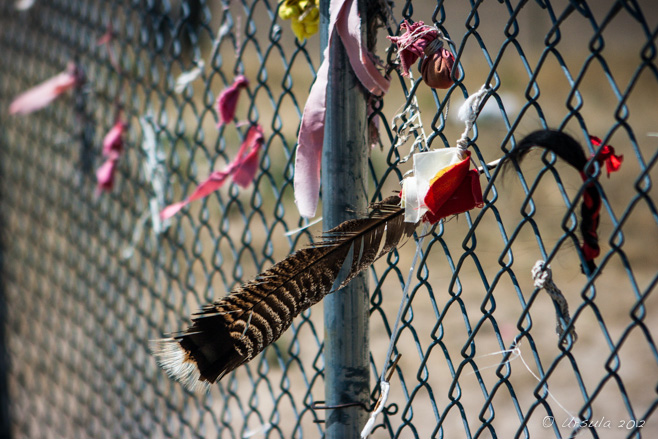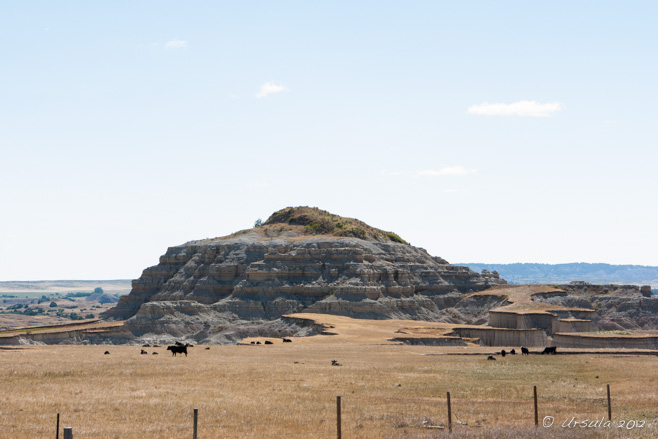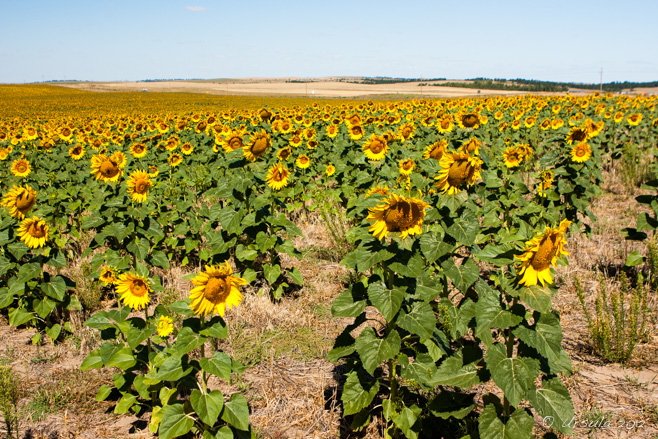
Catching Dreams
Ribbons and feathers for loved ones wave on the wind on the graveyard fence, Wounded Knee, SD
We drove across North Dakota on our road trip this summer: about 350 miles – almost all of them dead straight – through black dirt and green hills, and under a dark, looming sky.
It made me think about our visit to neighbouring South Dakota last year.
Granted, the landscape further south was different: hotter, drier, with more buttes and badlands. But I felt the same sense of oppressive gloom. In North Dakota, it was the weather – and the glum resignation of the young staff at the Visitor Centre when we said we weren’t stopping, but were driving through. “Su-ure. Like most people,” she responded in her Scandinavian-derived sing-song, shrugging dolefully.
In South Dakota, it was the history.
My husband and I were driving east from Cody WY, headed for Kadoka SD, where we planned to stay two nights so we could visit the South Dakota Badlands. As we sailed across the night, we realised we were bypassing Mt Rushmore. So, we decided to back-track. We looked at the map, and, instead of following a straight trip back along the same Highway 90, we traced a route south and around, through the Pine Ridge Indian Reservation and past historic Wounded Knee.

Mesa on Highway 73 South
The land south of Kadoka is hot, dry and dramatic.

Sunflowers
Sunflowers, wheat, and hay appear to be the only crops.

Stop!
Road works are everywhere, and Native Lakota from the Pine Ridge Indian Reservation are on the job.

A Kadoka School
School’s out! The “Drug and Weapon Free Zone” sign shouldn’t really be necessary, should it?

Slow!
A Lakota woman working the road crews smiles as she makes us wait –

Follow Me!
… and we are finally off, through the dust and heat –

Golden Bales
– past ploughed fields and to the next road works.

Storage Silos on the Horizon

Lakota Arts and Crafts, Wounded Knee
This inauspicious site is our first indication of what is supposed to be an official U.S. National Historic Landmark.
I guess every country and culture has moments that it is not proud of; Wounded Knee has seen two major cultural clashes, both of which arose out of stubbornness and resulted in loss of life.
The original battle, the Wounded Knee Massacre, took place on December 29, 1890. Causes are never simple, but the combination of: bison herds being hunted to near extinction; Sioux people being forced off their lands after dubious unfulfilled treaty agreements; the recent death of Sitting Bull, eight of his supporters and six policemen; a new Native American Ghost Dance religion that had believers thinking they were immune to bullets; over-zealous and heavy-handed Cavalry; and firearms discharged (accidentally and intentionally) at close range, resulted in a pursuit and massacre of up to 300 Lakota (mostly women and children) and the death of more than 25 soldiers, many by friendly fire.
Three days of blizzard followed, and the civilians hired to bury the dead Lakota found the bodies frozen. Even so, four infants were reportedly found alive. One of these was the child who came to be called Zintkala Nuni, or Lost Bird. She was handed around for some time before being adopted by Gen. Leonard Colby, whose suffragist wife, Clara Bewick Colby, was left to raise her – especially after he abandoned Clara for Zintkala’s nursemaid/governess and failed to provide adequate support for either dependent.
Lost Bird endured a short and difficult life, accepted by neither culture, and suffering from prejudice, poverty, abuse and violence before ultimately succumbing to influenza and dying on Valentine’s Day at age twenty-nine. In 1991, her body was moved from her pauper’s grave in California to the sad little graveyard at Wounded Knee. One of the young men I spoke with was an infant at the time, but his eyes grew wistful as he remembered his grandfather presiding over the ritual ceremonies conducted on that day.

Headstones
Graveyard, Wounded Knee

Final Resting Place
Zintkala Nuni (Little Lost Bird) is finally home at Wounded Knee.

Feathers on the Fence
Catching dreams and memories for loved ones…
The second Wounded Knee Incident was in 1973, when the town was occupied by members of the Oglala Civil Rights Organization (OSCRO) and the American Indian Movement (AIM) and became the rallying point for an often violent protest against the corruption of a local tribal president, and the failure of the US government to fulfill treaty promises.

Lakota Center, Wounded Knee
In a round building in the middle of nowhere…

Manning the Centre
… a Lakota man tried to explain the history of the centre and of his people.
The whole atmosphere was ineffably sad. Both the place and the people seemed wounded – with the scarring improperly healed. The young men I spoke to talked about the conflict of cultures and the lack of opportunities. One worked as an itinerant farm hand – when there was work to be had. He used to have six cows himself, but sold them during hard times. He told us how, the other morning, half asleep, he found a neighbouring (white) rancher’s cows on his doorstep. “For a moment, I thought I’d got lucky,” he mused dreamily. Then he woke up with a deep sigh.
It is hard to know how to respond to that kind of hopelessness.
Feeling deeply affected, we continued west and stopped at the small city of Hot Springs for lunch.
There, we learned about a whole different historical epoch. As it turns out, Hot Springs is home to a karst sinkhole formed approximately 26,000 years ago. During the last ice age, mammoths and other animals were attracted to the warm spring waters and the vegetation growing around the pond. Once in the steeply-sided pond, the animals could not escape, dying of starvation, exhaustion, or drowning.
The covered-over sink hole was discovered in 1974 when the owner of the property found what turned out to be mammoth bones on his land. The property was sold back to a trust, and The Mammoth Site was born. A climate-controlled building was constructed over what is now a working paleontological dig and a fascinating view into the plants and animals of the Pleistocene era. So far, the fossil evidence of 58 columbian mammoths and 3 woolly mammoths (all male; mostly young) have been found, along with remains of plants, giant short-faced bear, camel, llama, prairie dog, wolf, fish, and numerous invertebrates.

Brandon
Our “interpreter” was informative and amusing, as he walked us through the history of the centre and the geology of the site.

Painstaking Work
Uncovering the fossils takes patience and time – students at all levels and visiting professionals take turns working the dig.

Walkway
The elevated walkway allows visitors a good view of the site and the work going on, but still keeps them out of the way.
It was a fascinating visit, and elevated our mood somewhat after the morning’s experience. Checking the maps again and realising we could drive through Wind Cave National Park and Custer State Park to get to Mt Rushmore, cheered us up further.

A Big Male
After their near extinction in the late 1800s, bison were saved by the American Bison Society and reintroduced to the park in 1913-1914.

Bison Herd
Bison numbers have grown; too late, of course, for the Lakota and other Sioux tribes.

White-Tailed Deer (Odocoileus virginianus)
A mother deer with her young fawn, watches the road skittishly.

Baby Burro
The now-wild burros of Custer State Park beg for food from drivers.

A Pair of Pronghorn
Pronghorn (Antilocapra americana) are now quite numerous in western states.

The Iron Mountain Road
This feat of engineering winds through the Black Hills and passes through three tunnels that frame a very faint Mount Rushmore in the distance.

Over the Woods
Pine and spruce forests, Custer State Park

Tunnel Vision
Mount Rushmore in the distance.

Mt Rushmore
By the time we reached Mt Rushmore, the shadows had grown long, and I’d lost enthusiasm for visiting oversized carvings of powerful white men, etched into a mountain with little regard for the original residents of the Black Hills below. According to “Honor the Treaties”, a short film I came across recently, 90% of Lakota today live below the US poverty line the life expectancy of males is only 47.

Afternoon Light over the Dakota Grasslands

Sunset over the Black Hills
 Sobering thought – after a long day’s drive through the sacred hills.
Sobering thought – after a long day’s drive through the sacred hills.
Lets hope they can do better in the future.
Photos: 17August2012
































.png)


A day of widely ranging emotions, with stark beauty
very interesting report Ursula. Greetings, Dietmut
My mother taught weaving on the Pine Ridge reservation during the ’70s. She was arrested and thrown in jail while trying to leave the reservation after the news reported the stand off was over. Crazy sad history there. Another terrible epoch in American history was the 1864 Sand Creek Massacre in Eastern Colorado, where one of my ancestors was involved in the killing of many Cheyenne women and children.
Your mother was clearly an amazing woman in her day, Katy! I guess that is where you get your grit. 😀
The whole “clash of cultures/beliefs” thing is ineffably sad, isn’t it? And, we as a people don’t seem to be getting any more tolerant of difference.